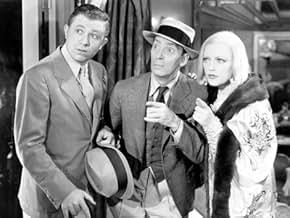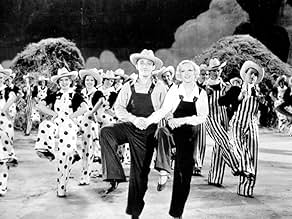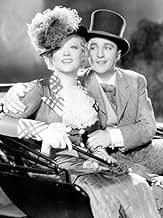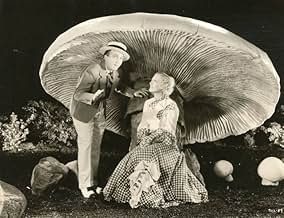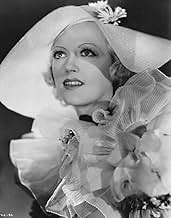Ajouter une intrigue dans votre langueA love-struck teacher pursues a radio singer to Hollywood.A love-struck teacher pursues a radio singer to Hollywood.A love-struck teacher pursues a radio singer to Hollywood.
- Réalisation
- Scénario
- Casting principal
- Récompenses
- 3 victoires et 1 nomination au total
The Radio Rogues
- The Radio Rogues
- (as Three Radio Rogues)
Sam Appel
- Mexican Bartender
- (non crédité)
Henry Armetta
- Henry Armetta
- (images d'archives)
- (non crédité)
Eddie Bartell
- Member - Three Radio Rogues
- (non crédité)
Wallace Beery
- Wallace Beery - Premiere Clip
- (images d'archives)
- (non crédité)
Clara Blandick
- Miss Perkins - Divinity Teacher
- (non crédité)
Harry Bowen
- Bartender
- (non crédité)
Nora Cecil
- Briarcroft's Teacher
- (non crédité)
Onest Conley
- Tap Dancer
- (non crédité)
Ken Darby
- Member - The King's Men
- (non crédité)
Jon Dodson
- Member - The King's Men
- (non crédité)
Avis à la une
'Going Hollywood's' biggest attraction was Bing Crosby, who had one of the most beautiful and distinctive male (and in general) singing voices on film, as well as being a master of how to use it.
Crosby is certainly the best thing about 'Going Hollywood'. He seems relaxed, has a lot of charm and looks and sounds wonderful, his beautiful smooth voice used with impeccable phrasing and control as always. Great songs also helps, something that 'Going Hollywood' certainly has, the standouts being the title song, "Temptation" and "Beautiful Girl".
Of the production numbers, choreographically the best is the train station sequence which is so lively and entertaining. Although Raoul Walsh did seem a bit of an odd choice at first as director, often going for the tougher and darker edge to his films, but he does direct with a light touch without being too lightweight. Really enjoyed Patsy Kelly, who brings plenty of sass and allure. While going on a little too long, the Three Radio Rogues are also entertaining, and while overlong and overblown parts of the dream sequence are quite sweet.
However, was very much mixed on Marion Davies. She is attractive and does bring some charm and fun, but at other points she does look stiff and limitations in her singing and dancing show. Stuart Erwin has an appealing earnestness but has little to do, while Ned Sparks does smarmy well but the character is written with so little variation that it feels one-dimensional. Worst of all is Fifi D'Orsay, her character being an annoying cartoonish caricature made even more insufferable by that D'Orsay overacts to such a wild degree.
While some of the dream sequence was quite nice, the dancing scarecrows part does feel really bizarre and also jars. The bit with the blackface is neither cute or funny and even those who hardly ever scream racism will find it in bad taste. The script has some wit, but is also shallow and flaccid. The story while at first lively in pace constantly feels too convenient and too neatly wrapped up, while also dragging towards the end, having a premise and romance that rarely rings true and being paper thin. Characterisation is even thinner, development practically forgotten about.
All in all, many charms but also some big caveats. 5/10 Bethany Cox
Crosby is certainly the best thing about 'Going Hollywood'. He seems relaxed, has a lot of charm and looks and sounds wonderful, his beautiful smooth voice used with impeccable phrasing and control as always. Great songs also helps, something that 'Going Hollywood' certainly has, the standouts being the title song, "Temptation" and "Beautiful Girl".
Of the production numbers, choreographically the best is the train station sequence which is so lively and entertaining. Although Raoul Walsh did seem a bit of an odd choice at first as director, often going for the tougher and darker edge to his films, but he does direct with a light touch without being too lightweight. Really enjoyed Patsy Kelly, who brings plenty of sass and allure. While going on a little too long, the Three Radio Rogues are also entertaining, and while overlong and overblown parts of the dream sequence are quite sweet.
However, was very much mixed on Marion Davies. She is attractive and does bring some charm and fun, but at other points she does look stiff and limitations in her singing and dancing show. Stuart Erwin has an appealing earnestness but has little to do, while Ned Sparks does smarmy well but the character is written with so little variation that it feels one-dimensional. Worst of all is Fifi D'Orsay, her character being an annoying cartoonish caricature made even more insufferable by that D'Orsay overacts to such a wild degree.
While some of the dream sequence was quite nice, the dancing scarecrows part does feel really bizarre and also jars. The bit with the blackface is neither cute or funny and even those who hardly ever scream racism will find it in bad taste. The script has some wit, but is also shallow and flaccid. The story while at first lively in pace constantly feels too convenient and too neatly wrapped up, while also dragging towards the end, having a premise and romance that rarely rings true and being paper thin. Characterisation is even thinner, development practically forgotten about.
All in all, many charms but also some big caveats. 5/10 Bethany Cox
This musical comedy features beautiful Marion as a bored French teacher who runs off to Hollywood. Seems like a standard 30s musical. But wait. The narrative structure of this film is more complex than it at first seems.
At a teachers' meeting at the Briarcroft School, one old maid complains that Davies (she teaches French) is always late because she spends too much time dreaming. They take her some papers to correct and find her.
When Davies turns on the radio and gazes out at the night sky she starts to wish upon a star. Just as she says "I wish I may, I wish I might...." Bing Crosby's voice cuts across the moment as he begins the lyric of "Our Big Love Scene": "Don't waste the night in wishing..." as though in answer to Davies' wish upon a star. She sits up, startled, and packs her bags.
So sets off not to go to Hollywood, but only to find Crosby, who plays a famous radio singer about to embark by train to Hollywood to star in a picture. Crosby is also involved with the picture's French star, played by Fifi D'Orsay. As Crosby is packing up to go, and after a live broadcast of his singing "Beautiful Girl" to Sterling Holloway, Davies finds him. He brushes her off as just another fan and heads to the Grand Central Station, where he sings "Going Hollywood."
On the train, who should show up but Davies. In today's context, Davies is certainly a crazed fan stalking her idol, but in 1933 her actions were (in the context of this film) acceptable. D'Orsay catches the two together (Davies is correcting Crosby's French pronunciation) and immediately suspects them of being up to something. D'Orsay is on the rampage because her maid has quit. Of course Davies becomes her maid, having taught French and all. The second time D'Orsay catches them together, she slaps Davies. Davies quits her job.
Next we find Davies in Hollywood at "Central Casting," asking to see Crosby. She's turned away and meets Patsy Kelly, a film extra. They hit it off right away, and Kelly invites Davies to share her digs. The director (Ned Sparks) walks by and hires them as extras in the film starring Crosby and D'Orsay.
At Kelly's bungalow, Davies takes a nap and has a bizarre dream about herself and Crosby starring in a surreal production number called "We'll Make Hay While the Sun Shines." While Davies dreams, we are shown a huge close up of her face, which is occasionally superimposed over the dream-scene action so that we don't forget it's all a dream. The scene opens with Crosby and Davies in a cozy cottage. Crosby starts the song, and the couple is strolling through a field of giant, swaying daisies and then sitting in a carriage where Davies joins Crosby in a brief duet. They come upon a farm scene of dancing scarecrows . Suddenly Davies emerges from the dancers and takes center stage in a dance lively number. But Crosby and Davies are still sitting in the carriage. Davies points to herself dancing and asks Crosby, "me?" He nods and soon he also is in the dance number. A windstorm suddenly comes up and everyone is drenched by the downpour. Crosby and Davies run back to the cozy cottage where they sit by the fire, wrapped in blankets, while Crosby finishes the song.
On the movie set, Davies once again finds Crosby. He's in between scenes when Davies approaches. She's in blackface and dressed like Aunt Jemima. He doesn't seem to notice that she is not really black. D'Orsay catches them again and slaps Davies for a second time.
Next we're on location and D'Orsay is about to sing her big number, "Cinderella's Fella." The number has a Cinderella theme with the blonde-wigged D'Orsay as the Prince. As she launches into the song, Sparks stops her and tells he she's doing it all wrong because she's doing it as a kooch dance. She throws a fit and storms off the set. Back in her trailer, Crosby tries to comfort her. Meanwhile, back on the set, the Radio Rogues do a series of impressions of current radio stars who include Kate Smith, Morton Downey, and Crosby's singing rival of the day-Russ Columbo.
Davies is then coaxed into doing an impression (Davies was famous for her ability to mimic, and does so in several of her films). Of course she launches into an impression of D'Orsay singing. D'Orsay hears this and marches out to catch Davies in mid-dance and hauls off and slaps her for a third time. This time Davies strikes back and delivers D'Orsay a black eye. D'Orsay quits and Davies is hired to star in the film! Talk about your Hollywood dream!
There is an abbreviated scene, with Davies and Crosby dating, with Crosby singing the wonderful "After Sundown." Later, Davies attempts to deliver some flowers to Crosby, but standing in the hallway outside his door she hears D'Orsay talking to Crosby.
D'Orsay lures Crosby to a Mexican bar and plies him with drinks, knowing he will be fired from the picture after being absent for days. Davies tracks him down yet again and tries to get him back but he's drunk and can't think straight. This sets up the film's best number and another yet dream sequence. Crosby sings "Temptation" while sitting at the bar and drinking what looks like absinthe. As he sings we see huge close-ups of D'Orsay (to match the close-ups of Davies in the previous dream sequence) and cutaway shots of a dance floor crowded with same-sex couples. In the bar itself, no one is dancing. As Crosby approaches the last notes of the song, he lifts his glass and drains the last drops. It's an amazing sequence.
The scene shifts back to the film set where, after seeing a dance montage to "Cinderella's Fella," Davies is about to film an elaborate production number, be-gowned in a massive ermine and sequin outfit. As she is about to begin the scene with Crosby's replacement, Bing can be heard reprising "Our Big Love Scene," and the lovers meet. End of film.
At a teachers' meeting at the Briarcroft School, one old maid complains that Davies (she teaches French) is always late because she spends too much time dreaming. They take her some papers to correct and find her.
When Davies turns on the radio and gazes out at the night sky she starts to wish upon a star. Just as she says "I wish I may, I wish I might...." Bing Crosby's voice cuts across the moment as he begins the lyric of "Our Big Love Scene": "Don't waste the night in wishing..." as though in answer to Davies' wish upon a star. She sits up, startled, and packs her bags.
So sets off not to go to Hollywood, but only to find Crosby, who plays a famous radio singer about to embark by train to Hollywood to star in a picture. Crosby is also involved with the picture's French star, played by Fifi D'Orsay. As Crosby is packing up to go, and after a live broadcast of his singing "Beautiful Girl" to Sterling Holloway, Davies finds him. He brushes her off as just another fan and heads to the Grand Central Station, where he sings "Going Hollywood."
On the train, who should show up but Davies. In today's context, Davies is certainly a crazed fan stalking her idol, but in 1933 her actions were (in the context of this film) acceptable. D'Orsay catches the two together (Davies is correcting Crosby's French pronunciation) and immediately suspects them of being up to something. D'Orsay is on the rampage because her maid has quit. Of course Davies becomes her maid, having taught French and all. The second time D'Orsay catches them together, she slaps Davies. Davies quits her job.
Next we find Davies in Hollywood at "Central Casting," asking to see Crosby. She's turned away and meets Patsy Kelly, a film extra. They hit it off right away, and Kelly invites Davies to share her digs. The director (Ned Sparks) walks by and hires them as extras in the film starring Crosby and D'Orsay.
At Kelly's bungalow, Davies takes a nap and has a bizarre dream about herself and Crosby starring in a surreal production number called "We'll Make Hay While the Sun Shines." While Davies dreams, we are shown a huge close up of her face, which is occasionally superimposed over the dream-scene action so that we don't forget it's all a dream. The scene opens with Crosby and Davies in a cozy cottage. Crosby starts the song, and the couple is strolling through a field of giant, swaying daisies and then sitting in a carriage where Davies joins Crosby in a brief duet. They come upon a farm scene of dancing scarecrows . Suddenly Davies emerges from the dancers and takes center stage in a dance lively number. But Crosby and Davies are still sitting in the carriage. Davies points to herself dancing and asks Crosby, "me?" He nods and soon he also is in the dance number. A windstorm suddenly comes up and everyone is drenched by the downpour. Crosby and Davies run back to the cozy cottage where they sit by the fire, wrapped in blankets, while Crosby finishes the song.
On the movie set, Davies once again finds Crosby. He's in between scenes when Davies approaches. She's in blackface and dressed like Aunt Jemima. He doesn't seem to notice that she is not really black. D'Orsay catches them again and slaps Davies for a second time.
Next we're on location and D'Orsay is about to sing her big number, "Cinderella's Fella." The number has a Cinderella theme with the blonde-wigged D'Orsay as the Prince. As she launches into the song, Sparks stops her and tells he she's doing it all wrong because she's doing it as a kooch dance. She throws a fit and storms off the set. Back in her trailer, Crosby tries to comfort her. Meanwhile, back on the set, the Radio Rogues do a series of impressions of current radio stars who include Kate Smith, Morton Downey, and Crosby's singing rival of the day-Russ Columbo.
Davies is then coaxed into doing an impression (Davies was famous for her ability to mimic, and does so in several of her films). Of course she launches into an impression of D'Orsay singing. D'Orsay hears this and marches out to catch Davies in mid-dance and hauls off and slaps her for a third time. This time Davies strikes back and delivers D'Orsay a black eye. D'Orsay quits and Davies is hired to star in the film! Talk about your Hollywood dream!
There is an abbreviated scene, with Davies and Crosby dating, with Crosby singing the wonderful "After Sundown." Later, Davies attempts to deliver some flowers to Crosby, but standing in the hallway outside his door she hears D'Orsay talking to Crosby.
D'Orsay lures Crosby to a Mexican bar and plies him with drinks, knowing he will be fired from the picture after being absent for days. Davies tracks him down yet again and tries to get him back but he's drunk and can't think straight. This sets up the film's best number and another yet dream sequence. Crosby sings "Temptation" while sitting at the bar and drinking what looks like absinthe. As he sings we see huge close-ups of D'Orsay (to match the close-ups of Davies in the previous dream sequence) and cutaway shots of a dance floor crowded with same-sex couples. In the bar itself, no one is dancing. As Crosby approaches the last notes of the song, he lifts his glass and drains the last drops. It's an amazing sequence.
The scene shifts back to the film set where, after seeing a dance montage to "Cinderella's Fella," Davies is about to film an elaborate production number, be-gowned in a massive ermine and sequin outfit. As she is about to begin the scene with Crosby's replacement, Bing can be heard reprising "Our Big Love Scene," and the lovers meet. End of film.
French teacher Sylvia Bruce (Marion Davies) teaches at an exclusive boarding school for girls where all of the other teachers are decades older than she is. She's restless and dissatisfied with her sterile environment. Then one night Sylvia turns on her radio and hears crooner Bill WIlliams (Bing Crosby) singing. He makes her feel alive again, so she packs her bags and leaves the school.
Sylvia ends up on the train to Hollywood that Bill is taking as he is going to make a movie. Not only does she tell Bill how much his singing meant to her, she declares her love for him. They don't know one another, they've never even met. The best way to describe her is a weird stalker character. Even though Bill has expressed dismay at her declaration and is obviously keeping company with the French actress of the film, Lili Yvonne (Fifi D'orsay), Sylvia still pursues him.
At first she gets a job as Lili's maid. When that doesn't work out she follows him to the studio and gets a job as an extra so she can get close to him that way. In the 21st century this would be a neo-noir with creepy music to match Sylvia's creepy behavior. I would bring up "Fatal Attraction" as a comparison, but at least there Michael Douglas was initially attracted to Glenn Close's character and did make the first move.
The plot is thin in this one - there's a pedestrian radio act inserted into the middle of the film that goes on interminably, probably just to pad the running time so it gets past an hour.
What's good about it? There are several great standards sung by Bing in top vocal form - "Beautiful Girl", "Temptation", and "Going Hollywood". Ned Sparks is great as an ascerbic director. Stu Erwin is the financial backer of the film who seems to be his normal passive self until he surprisingly finds his voice late. The production values are top notch - It's just that horrible plot!
I guess that in 1933, like now, wads of cash can cover a multitude of sins, and they sure covered William Randolph Hearst's sins in thinking he knew much about the art of motion picture making.
Sylvia ends up on the train to Hollywood that Bill is taking as he is going to make a movie. Not only does she tell Bill how much his singing meant to her, she declares her love for him. They don't know one another, they've never even met. The best way to describe her is a weird stalker character. Even though Bill has expressed dismay at her declaration and is obviously keeping company with the French actress of the film, Lili Yvonne (Fifi D'orsay), Sylvia still pursues him.
At first she gets a job as Lili's maid. When that doesn't work out she follows him to the studio and gets a job as an extra so she can get close to him that way. In the 21st century this would be a neo-noir with creepy music to match Sylvia's creepy behavior. I would bring up "Fatal Attraction" as a comparison, but at least there Michael Douglas was initially attracted to Glenn Close's character and did make the first move.
The plot is thin in this one - there's a pedestrian radio act inserted into the middle of the film that goes on interminably, probably just to pad the running time so it gets past an hour.
What's good about it? There are several great standards sung by Bing in top vocal form - "Beautiful Girl", "Temptation", and "Going Hollywood". Ned Sparks is great as an ascerbic director. Stu Erwin is the financial backer of the film who seems to be his normal passive self until he surprisingly finds his voice late. The production values are top notch - It's just that horrible plot!
I guess that in 1933, like now, wads of cash can cover a multitude of sins, and they sure covered William Randolph Hearst's sins in thinking he knew much about the art of motion picture making.
If you like to see the original crooner of all times and really the King of male singers. Bing was a great actor in this film along with super star Marion Davies, who was like the Marilyn Monroe during her days and even Jean Harlow. Marion Davies was also a long time friend of William Randolph Hearst, the newspaper magnet of California. Bing Crosby sings,"You were Temptation" and he must have charmed all the ladies hearts of those days. Wallace Berry, veteran actor has a brief role in this film and is uncredited along with the great Mae Clarke. This is really what Hollywood films were like in the Golden era of movies. It is a must view film.
Bing Crosby truly was the quintessential vocalist of his time. I strongly recommend Gary Giddins bio on Bing; an excellent reference.
Anyway, the story may be weak in this film, but the songs and Bing's clear baritone voice make up for it.
An interesting tidbit about this film: Of course Marion Davies was W.R. Hearst's mistress, and Hearst financed the film. Ms. Davies thus took full advantage of the situation by showing up for filming at 10 AM, shooting a scene or two before a four hour lunch replete with all the catered trimmings and wines. The day wound down by 4PM.
It's no wonder it took six months to shoot this film in an era when the typical film was shot in 2 weeks!
Anyway, the story may be weak in this film, but the songs and Bing's clear baritone voice make up for it.
An interesting tidbit about this film: Of course Marion Davies was W.R. Hearst's mistress, and Hearst financed the film. Ms. Davies thus took full advantage of the situation by showing up for filming at 10 AM, shooting a scene or two before a four hour lunch replete with all the catered trimmings and wines. The day wound down by 4PM.
It's no wonder it took six months to shoot this film in an era when the typical film was shot in 2 weeks!
Le saviez-vous
- AnecdotesWhen Marion Davies requested Bing Crosby as her leading man for this film, he was under contract to Paramount, where they had him starring in shorts and a series of college themed films with Jack Oakie. The success of this film moved Crosby into starring roles at Paramount with the likes of Carole Lombard and Miriam Hopkins, a definite step upwards.
- Citations
Bill 'Billy' Williams: [singing] Out where they say, "Let us be gay," I'm going Hollywood. I'll ballyhoo greetings to you, I'm going Hollywood. Hey, while you sleepyheads are in that hay, I'll be dancing - I'm gonna be dancing with a sun-kissed baby. And I'm on my way - here's my beret, I'm going Hollywood!
- ConnexionsEdited into The Big Idea (1934)
- Bandes originalesGoing Hollywood
(1933) (uncredited)
Music by Nacio Herb Brown
Lyrics by Arthur Freed
Played during the opening credits
Sung by Bing Crosby at the railroad station
Played as background music twice
Meilleurs choix
Connectez-vous pour évaluer et suivre la liste de favoris afin de recevoir des recommandations personnalisées
Détails
- Date de sortie
- Pays d’origine
- Site officiel
- Langues
- Aussi connu sous le nom de
- Going Hollywood
- Lieux de tournage
- Sociétés de production
- Voir plus de crédits d'entreprise sur IMDbPro
Box-office
- Budget
- 914 000 $US (estimé)
- Durée
- 1h 18min(78 min)
- Couleur
- Rapport de forme
- 1.37 : 1
Contribuer à cette page
Suggérer une modification ou ajouter du contenu manquant

